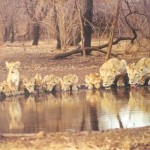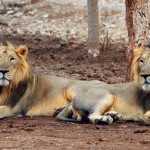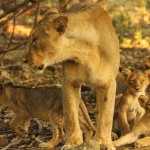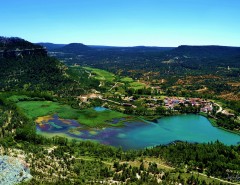The Gir Forest National Park and Wildlife Sanctuary (also known as Sasan-Gir, and गिर वन) is a forest and wildlife sanctuary near Talala Gir in Gujarat, India. Established in 1965, with a total area of 1,412 km2 (545 sq mi) (about 258 km2 (100 sq mi) for the fully protected area of the national park and 1,153 km2 (445 sq mi) for the Sanctuary, the park is located 43 km (27 mi) north-east of Somnath, 65 km (40 mi) south-east of Junagadh and 60 km (37 mi) south-west of Amreli.
Its region is the sole home of the Asiatic lion (Panthera leo persica) in the wilderness, and is considered to be one of the most important protected areas in Asia due to its supported species. The ecosystem of Gir, with its diverse flora and fauna, is protected as a result of the efforts of the government forest department, wildlife activists and NGOs. The forest area of Gir were the hunting grounds of the Nawabs of Junagadh. However, faced with a drastic drop in the lion population in Gir, Nawab Sir Muhammad Rasul Khanji Babi declared Gir as a “protected” area in 1900. His son, Nawab Muhammad Mahabat Khan III later assisted in the conservation of the lions whose population had plummeted to only 20 through slaughter for trophy hunting.
The 14th Asiatic Lion Census 2015 was conducted in May 2015. In 2015, the population has been 523 (27% up compared to previous census in 2010). The population was 411 in 2010 and 359 in 2005. The population of lions in Junagadh District has been 268, Gir Somnath District has been 44, Amreli District has been 174 (highest increase) and Bhavangar District has been 37. There are 109 males, 201 females and 213 young/cubs.
Geography
A panorama of the reservoir
The seven major perennial rivers of the Gir region are Hiran, Shetrunji, Datardi, Shingoda, Machhundri, Godavari and Raval. The four reservoirs of the area are at four dams, one each on Hiran, Machhundri, Raval and Shingoda rivers, including the biggest reservoir in the area, the Kamleshwar Dam, dubbed ‘the lifeline of Gir’. It is located at 21°08′08″N 70°47′48″E.
During peak summer, surface water for wild animals is available at about 300 water points. When drought hits the area following a poor rainfall, surface water is not available at a majority of these points, and water scarcity becomes a serious problem (mainly in the eastern part of the sanctuary). Ensuring the availability of water during peak summer is one of the major tasks of the Forest Department staff .
Flora
More than 400 plant species were recorded in the survey of Gir forest by Samtapau & Raizada in 1955. The Botany department of M.S. University of Baroda has revised the count to 507 during their survey. According to the 1964 forest type classification by Champion & Sheth, the Gir forest falls under “5A/C-1a—very dry teak forest” classification. Teak occurs mixed with dry deciduous species. The degradation stages (DS) sub-types are thus derived as: 5/DS1-Dry deciduous scrub forest and 5/DS1-Dry savannah forests (Locally known as “vidis”). It is the largest dry deciduous forest in western India.
Teak bearing areas are mainly in the eastern portion of the forest, which constitutes nearly half of the total area.Several species of acacia are found. Also found here are ber,jamun,babul,flame of the forest,zizyphus,tendu and dhak. Also plants like karanj,umlo,amli,sirus,kalam,charal and an occasional vad or banyan tree are found.These broadleaf trees provide a cool shade and moisture content to the region.As part of the afforestation programme cassuarina and prosopis
Wildlife
The count of 2,375 distinct fauna species of Gir includes about 38 species of mammals, around 300 species of birds, 37 species of reptiles and more than 2,000 species of insects.
The carnivores group mainly comprises Asiatic lions, Indian leopards, Indian cobras, jungle cats, striped hyenas, golden jackals, Indian mongoose, Indian palm civets, and honey badgers. Desert cats and rusty-spotted cats occur but are rarely seen. The main herbivores of Gir are chital, nilgai, sambar, four-horned antelope, chinkara and wild boar. Blackbucks from the surrounding area are sometimes seen in the sanctuary.
Among the smaller mammals, porcupine and hare are common, but the pangolin is rare. The reptiles are represented by the marsh crocodile, tortoise and monitor lizard which inhabit the sanctuary’s bodies of water. Snakes are found in the bush and forest. Pythons are sighted at times along the stream banks. Gir has been used by the Gujarat State Forest Department which formed the Indian Crocodile Conservation Project in 1977 and released close to 1000 marsh crocodiles into Lake Kamaleshwar and other small bodies of water in and around Gir.
The plentiful avifauna population has more than 300 species of birds, most of which are resident. The scavenger group of birds has 6 recorded species of vultures. Some of the typical species of Gir include crested serpent eagle, endangered Bonelli’s eagle, crested hawk-eagle, brown fish owl, Indian eagle-owl, rock bush-quail, Indian peafowl, brown-capped pygmy woodpecker, black-headed oriole, crested treeswift and Indian pitta. The Indian grey hornbill was not found from the last census of 2001.
Asiatic lion habitat, distribution and population
The Asiatic lion’s habitat is dry scrub land and open deciduous forest. These lions were once found across northern Africa, south west Asia and northern Greece. The lion population which was 411 in 2010 has increased to 523 in 2015 and all of them are in or around the Gir Forest National Park. The first modern day count of lions was done by Mark Alexander Wynter-Blyth, the principal of Rajkumar College, Rajkot and R.S. Dharmakumarsinhji sometime between 1948 and 1963, probably early in his tenure as the principal during that period. Even though the Gir Forest is well protected, there are instances of Asiatic lions being poached. They have also been poisoned for attacking livestock.
Some of the other threats include floods, fires and the possibility of epidemics and natural calamities. Gir nonetheless remains the most promising long term preserve for them. While most would see the lions as aggressive and dangerous, the lions of Gir rarely attack people. They live in a very close proximity to people, which makes their behavior different almost as if they have an acquaintanceship with the neighboring people. The lions who remember being hunted have now taken the higher road and stopped the circle of life.
The lion breeding programme and lion-counting
The Lion Breeding Programme creates and maintains breeding centres. It also carries out studies of the behaviour of the Asiatic lions and also practices artificial insemination. One such centre has been established in the Sakkarbaug Zoo at the district headquarters of Junagadh, which has successfully bred about 180 lions. 126 pure Asiatic lions have been given to zoos in India and abroad. The census of lions takes place every five years. Previously indirect methods like using pugmarks of the lion were adopted for the count. However, during the census of April 2005 (which originally was scheduled for 2006, but was advanced following the reports and controversy over vanishing tigers in India), “Block-Direct-Total Count” method was employed with the help of around 1,000 forest officials, experts and volunteers. It means that only those lions were counted that were “spotted” visually. Use of “live bait” (a prey that is alive and used as a bait) for the exercise, though thought to be a traditional practice, was not used this time. The reason believed to be behind this is the Gujarat High Court ruling of 2000 against such a use of animals.
During the 2010 census ‘The Cat Women of Gir Forest’ counted more than 411 lions in the park, and 523 in 2015. The women who do the counting are of traditional Muslim tribes in neighboring villages. There are over 40 women van raksha sahayaks, who seek only to protect the animals of the park. These women have worked hard to win cooperation not just from local villagers but also from maaldharis, the semi-nomadic tribal herdsmen who live in the sanctuary. While tourist numbers are increasing people do not seem to understand the phenomena taking place. The lions are almost tame in the presence of these female guards.
Gir Interpretation Zone, Devalia
Gir National Park and Sanctuary does not have a designated area for tourists. However, to reduce the tourism hazard to the wildlife and to promote nature education, an Interpretation Zone has been created at Devalia within the sanctuary. Within its chained fences, it covers all habitat types and wildlife of Gir with its feeding-cum-living cages for the carnivores and a double-gate entry system.
- Country – India
- State – Gujarat
- District – Gir Somnath
- Nearest city – Talala (Gir)
- Area – 1,412 km2 (545 sq mi)
- Established – 1965
- Visitors – 60,148 (in 2004)










